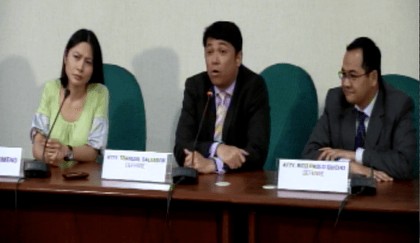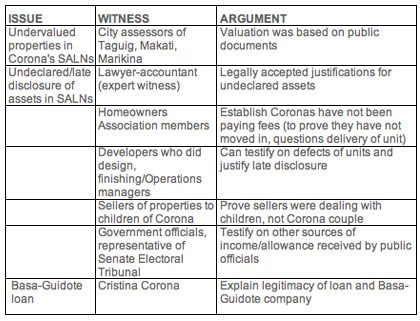SUMMARY
This is AI generated summarization, which may have errors. For context, always refer to the full article.

MANILA, Philippines – It’s now the turn of Chief Justice Renato Corona’s counsels to explain his side.
And the defense says, it is more than ready.
After the prosecution dropped 5 articles in the impeachment complaint against Corona, the defense spent this week re-organizing assignments among counsels. Lawyers have been assigned to deal with specific articles and in the case of article 2 — which the prosecution considers its strongest case — lawyers are assigned to a specific issue within the article.
Article 2 charges Corona with failure to disclose his Statement of Assets, Liabilities and Net Worth to the public. It has however, evolved and “gone beyond expectations” in the words of defense counsel Ramon Esguerra, after the prosecution presented evidence addressing allegations in the body of the article.
While the defense maintains that Article 2’s only charge in the complaint is the non-disclosure of SALNs, they plan to provide evidence to contest article 2.3, which alleges there were properties Corona failed to disclose in his SALNs.
Article 2.4, which accuses Corona of having accumulated ill-gotten wealth, was dropped by the senator-judges early on in the trial after they agreed with the defense that it was beyond the scope of Article 2.
The defense, however, has expressed continuous disappointment, saying the court’s admission of evidence relevant to 2.3 has allowed the prosecution to present documents and testimonies that are intrinsically tied to the accusation of ill-gotten wealth.
They will continue to insist on the inadmissibility of evidence relating to article 2.4.
What to expect
Under article 2, the defense will address the various charges made by the prosecution, with counsels assigned to various issues including property values, defects in units, sources of income, and so forth.
Below is the defense’s initial rough plan of witnesses they will present, to contest the prosecution’s charges (listed in random order).

The defense originally wanted to summon Supreme Court officials as well, but was forced to change plans because of the High Tribunal’s February 14 resolution barring justices and employees from testifying in the impeachment trial.
Most of the documentary evidence it included in the original list it submitted to the court may still be used by the defense as they are not affected by the resolution. See full list here.
Corona’s counsels will also continue to question if the non-disclosure of SALNs is an impeachable offense.
Other articles
Lead counsel Serafin Cuevas also verified the presentation of 3 congressmen who did not sign the complaint to testify that they were not given enough time to read the complaint. Representatives Jesus Crispin Remulla (Cavite), Hermilando Mandanas (Batangas), and Tobias Tiangco (Navotas) will take the stand despite the Senate’s refusal to issue subpoenas, citing parliamentary courtesy.
The defense has maintained that the impeachment complaint is “null and void” because it was transmitted without due notice and without hearing the Chief Justice. This is one of the reasons cited in a petition submitted to the Supreme Court by Corona asking the High Tribunal to stop the impeachment proceedings against him.
As for articles 3 and 7, Esguerra said the defense is likely to use documentary evidence rather than witnesses to argue its case since they are no longer allowed to summon Supreme Court officials.
The defense admits that the Supreme Court resolution, which also prevents the subpoena of documents pertaining to pending cases, has forced the defense to rely on public documents.
Corona’s counsels are not allowed to use the FASAP vs PAL rollo, but are allowed to use certified true copies of the decisions, orders and resolutions of the case, as well as letters of lawyer Estelito Mendoza as evidence. These and the resolution showing the inhibition of Corona in the FASAP case will be used to disprove the prosecution’s claims in article 3 that the Chief Justice acted on mere letters to change the decision.
The defense will also use the concurring opinions of justices pertaining to the issuance of a temporary restraining order (TRO) for Arroyo, to contradict the dissenting opinion of Justice Ma Lourdes Sereno as it pertains to article 7.
Article 3 charges Corona with enabling the flip-flopping of decisions by the Supreme Court, while Article 7 deals with Corona’s partiality in the issuance of a TRO favoring former President Gloria Macapagal-Arroyo.
Long nights
Esguerra said the defense will prepare their witnesses the best they can before presenting them to the court.
He acknowledged longer nights now that it is their turn to present, but they remain confident they will be able to respond to the allegations against the Chief Justice.
As for Corona taking the witness stand, Esguerra insisted the lawyers will decide depending on how the case and their presentation will evolve.
The Chief Justice has said he will leave the decision to his counsels but he is willing to testify. – Rappler.com
Add a comment
How does this make you feel?
There are no comments yet. Add your comment to start the conversation.